Ralph Breaks the Internet is almost out in theaters, which means the movie's review embargo has lifted. Check out our full review if you want to know what we thought, and keep reading to discover how the movie made the internet into a living, breathing city.
Everyone, including Ralph Breaks the Internet's new character Yesss, knows the first rule of the internet: Don't read the comments. Yesss, played by Taraji P. Henson, dispenses that wisdom to Ralph when the big guy stumbles into the comments room in the upcoming sequel. The scene raises a question: If you're not supposed to read the comments, why have a comments room at all? Because that's just how the internet works, as envisioned by the minds at Disney Animation.
Of course, Ralph (John C. Reilly) and his good pal Vanellope (Sarah Silverman) have to actually get to the internet before Ralph can break it. The original Wreck-It Ralph centered on the duo's arcade, which was grounded in the real, offline world. But in Ralph 2, Mr. Litwak (Ed O’Neill) buys a router, and that gives Ralph and Vanellope the fiber-optics highway they need to get online. With that concept in place, Disney had its work cut out: What is the internet like in the world of Wreck-It Ralph?
For inspiration, they looked to a real world hub of the internet: 1 Wilshire Blvd. in Los Angeles. This building is apparently a crossroads for all the internet traffic in North America--it all passes through 1 Wilshire. "This building is literally filled from top to bottom with wires and boxes," said Ralph Breaks the Internet co-director Rich Moore. "It was this research trip that began to inspire our version of what the internet might look like."
They took the look of 1 Wilshire, with all its multicolored wires, tubes, motherboards, and blinking servers, and combined it with the architecture and layout of a city, the endless screens of Times Square, and the signage and personality of an average street. The next step was natural: "If the internet was a city, the buildings would be the websites," said Matthias Lechner, the art director on environments.
So in the city of the internet, each website has its own building. That makes sense. But like the TARDIS, those buildings are bigger on the inside. "When you go in, much like the arcade games, they have their own world that's kind of abstract," said head of environments Larry Wu. Those worlds consist of things like, in the example of eBay, hundreds and thousands of auction booths where users are bidding on various items.
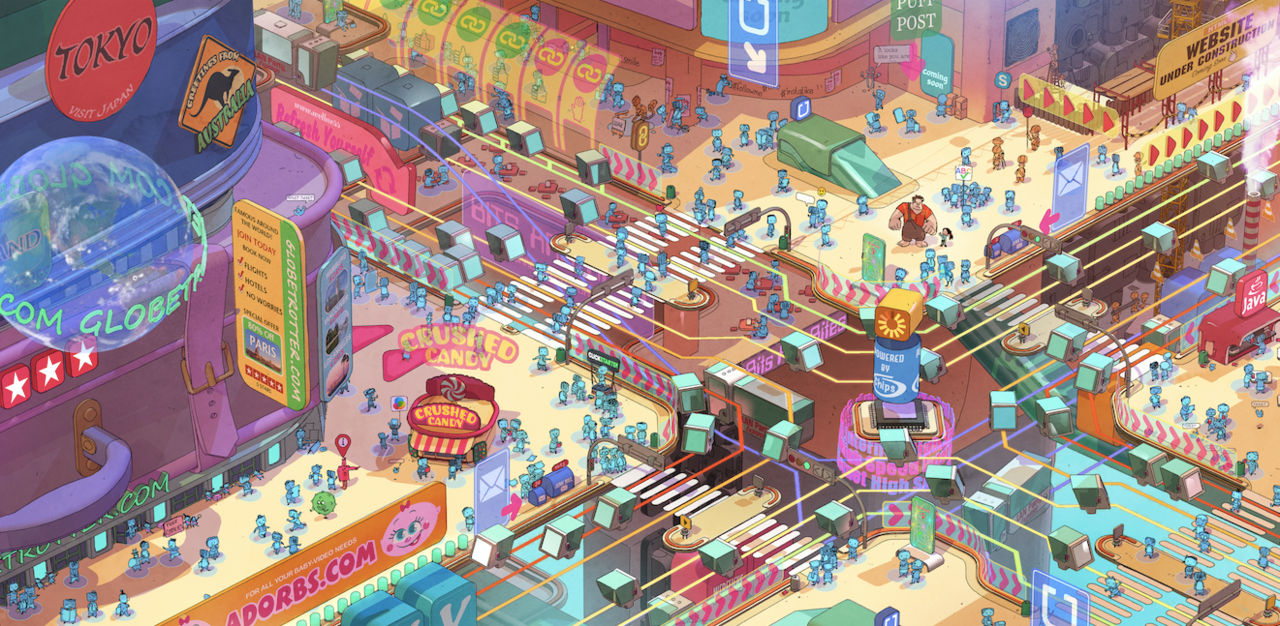
The environments team showed us an early test render that included tons of internet features, translated for the movie's cityscape language. "If you enter a travel website you get handed free cookies, and the website is made of suitcases," Lechner described. "There's somebody hashtagging with a spraycan on the wall. Somebody's cleaning up a data leak. These clocks in the center here are the loading wheel that you would find on your computer--because in my mind, the time you spend between websites is basically the time it would take to load on your computer. I'm trying to find some kind of logic in it."
Ralph Breaks the Internet features 150 master sets (what the studio calls unique environments where the characters spend some time) and 5,736 unique assets, most of them concentrated in the movie’s conception of the internet. In a given wide shot of the "city," there are 100,000 disparate elements.
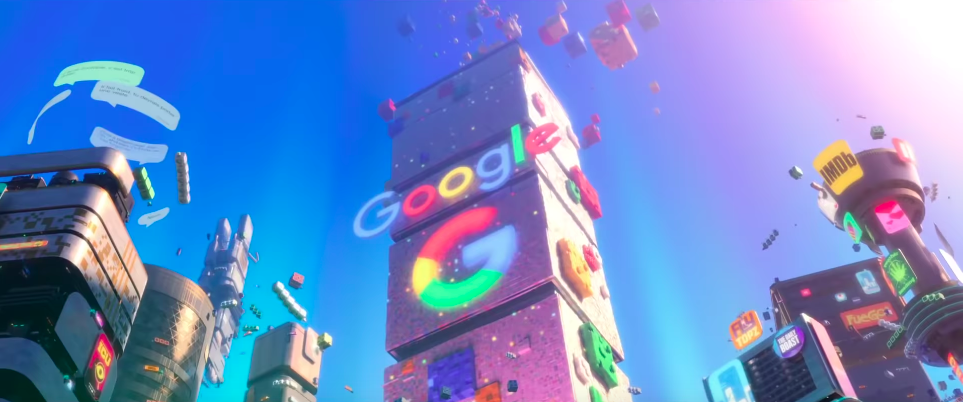
"The internet is building on top of itself all the time, right? So down at the bottom we might have a Myspace or a Netscape, but then like, Google has just been going and going and going, so it might be one of the biggest buildings in the internet," said head of characters and technical animation Dave Komorowski.
"In reality, the internet consists of the surface web, which is what you can reach through your browser or is searchable, and then there's the deep web, and the deep web is actually quite boring--it's archives, software, things behind paywalls, this kind of stuff that you can't just reach through a simple click in your browser," described Lechner.
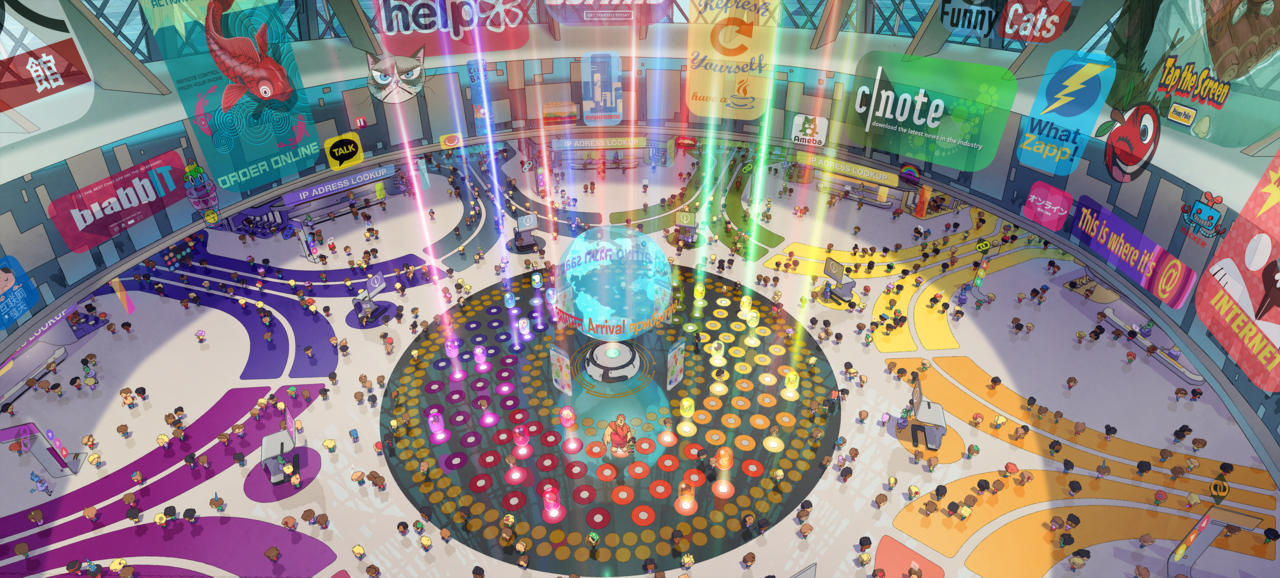
Underneath that is the dark web. "We imagine that our city is basically floating above this big abyss, which is the deep web, and at the very bottom of it, we imagine that all the discarded and outdated stuff sort of collects at the bottom," Lechner continued. "So you've got the Dial-Up Express, for example, which can only move as fast as the loading bars, that was the old transportation. And then if you take an encrypted elevator underground, there's a small area, the seedy underbelly of the internet, and this is where the users are all anonymous, where you can meet a lot of tricksters and viruses, and Ralph really shouldn't be there."
Residents of the Net
Anonymous or otherwise, it's not just internet users like you and me who populate Wreck-It Ralph 2's online metropolis. This world is full of characters, only half of whom are net users. The other half are Netizens, who fill a very different role.
The visual inspiration for the net users that represent real people were iOS app icons and the avatars that we create in various games and apps, according to production designer Cory Loftis. They're square-ish beings of uniform shape and size who seem deliberately customized--they're basically all the same, with different outfits, haircuts, and accessories.
Then there are the Netizens, the internet's native population. They're how things get done. "If you send an email, one of them is going to deliver it in a mail truck," Loftis said. "If you put something in your shopping cart, one of these Netizens is going to push that shopping cart to the check-out line and check you out. They are basically fulfilling all of the actions that you're performing on a website. They're kind of the worker bees of the internet."
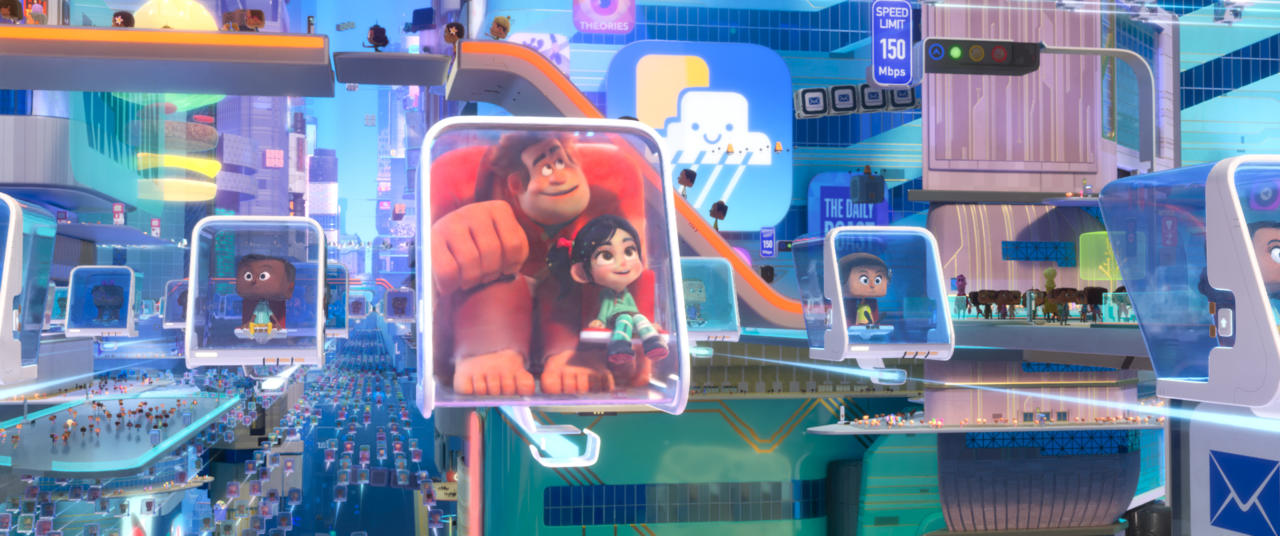
And they have personality. "They're thinking beings. They're sick of us," chuckled Komorowski, the head of characters and technical animation. "We irritate them, I think."
The filmmakers had to consider so many things--like how do user characters react to stimuli like users moving their mouse around? How is that cursor movement represented within the internet's world in the first place? How do different residents of the net get around? (Netizens can travel freely, while users are ferried from site to site in self-driving cars.) What would something as simple as a user browsing for items on Amazon or searching for tacos on Yelp look like?

Another important question for the movie's story team: How are memes made? Are there production lines of Netizens churning out viral content? Is there a meme factory that automatically generates random combinations of words? Or does Yesss simply design them all by hand?
The production team showed us tests they created early on, not for use in the final film, but as proofs of concept. Users carried out their actions while Netizens scrambled around to fulfill them. There's always a funny twist, like the user getting distracted by a video on their phone halfway through checkout, or texting and driving while a GPS Netizen is trying to give them directions.
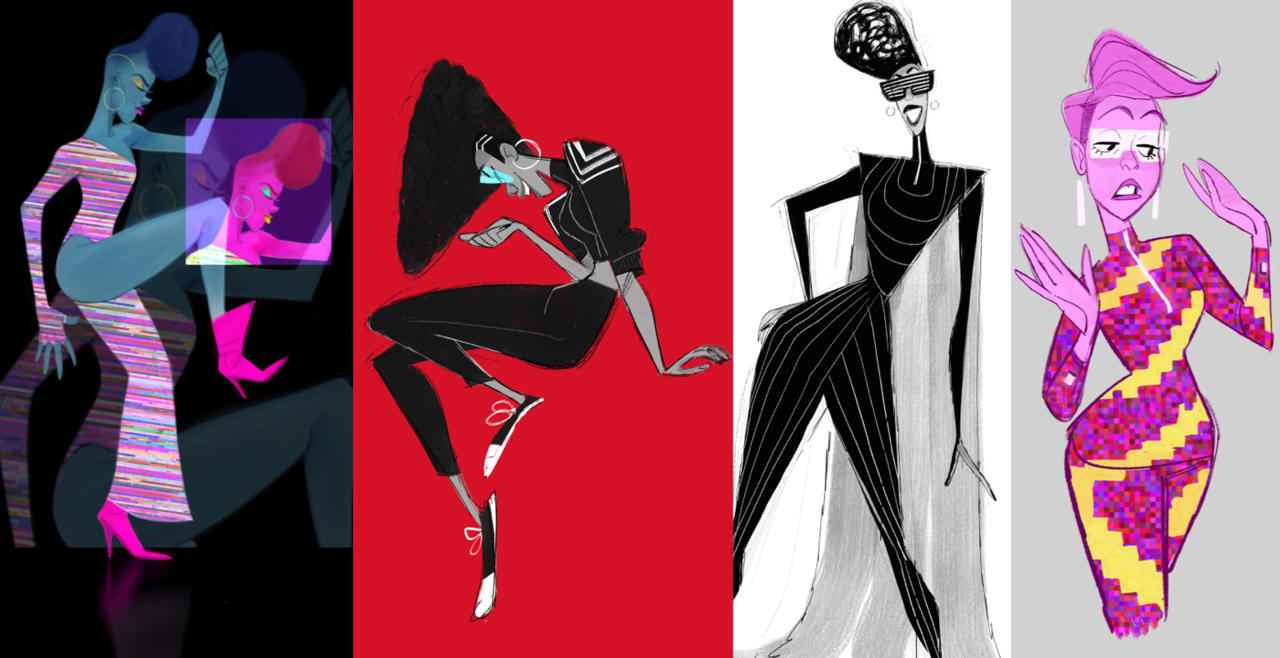
There are also specialized Netizens who stand out from the worker bees, like the character Yesss, who was designed to be someone who's so cool you actually believe she's an authority on every trend in existence. The search engine KnowsMore is another example. Design-wise, he started out as a lightbulb or an owl, before the production team landed on the humanoid, professorial Netizen in the final movie. There are even construction worker Netizens who are in charge of updates when a site goes under construction.
Not every website needed a specialized Netizen, though. "We went to a lot of websites to see what you actually do on there," Loftis said. "Like Twitter, there's not a lot going on when you go on there. You're pretty much typing your message and you're sending it out to the world. So we didn't feel like there was really a place for Netizens to live in there. What would they be doing? Like, you could imagine they were keeping coops of birds or something like that, but we were like, 'No, it's simpler just to have the birds deliver the tweets themselves.'"
"And we went through that with every single website," he continued. "We tried to think about what you're actually doing, what function is being done by the user, and what would the Netizen be doing? So we tailor-made those Netizens for each particular website, because each of them is a little bit different."
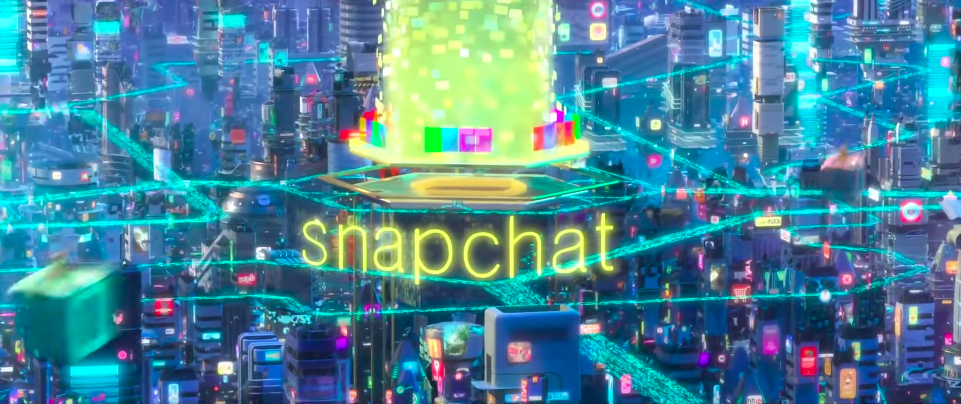
This movie's title promises that Ralph is going to break the internet, and for that to ultimately be meaningful, the internet has to be a place we develop some connection to in the film. Disney tried to strike a balance between real-world logic and the amount of whimsy that the story actually required.
"I think we had a phase in the beginning where we probably got too technical, because after you do the research, all the things that you learned, you want to put in the movie," said Lechner, the art director on environments. "But then just by story needs, you figure out what you need and what you don't need. The thing is, we didn't really build the internet. Everybody knows the internet, and it's not [a city]. So at some point, the city just becomes itself, and you just have to make it believable and make the audience buy it."
It may not be our internet, but if the filmmakers have accomplished their goal, it could be a place we enjoy even more. Ralph Breaks the Internet hits theaters November 21. If you want to learn more about it, check out how the movie doesn't shy away from the internet's dark side, or our condensed list of everything we learned about the movie from Disney.
